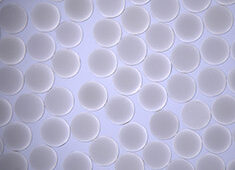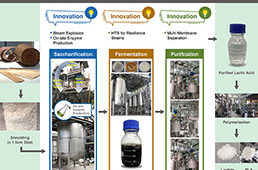
An environmentally-friendly, plant-based material that for the first time works better than Styrofoam for insulation. Credit: WSU
Researchers may have found a way to replace one of the scourges of the environment—polystyrene foam or Styrofoam.
A team from Washington State University has created an environmentally-friendly alternative foam made from the nanocrystals of cellulose, the most abundant plant material on Earth. The foam is made using a manufacturing process where potentially harmful solvents are replaced with water.
“This is a fundamental demonstration of the potential of nanocrystalline cellulose as an important industrial material,” Xiao Zhang, associate professor in the Gene and Linda School of Chemical Engineering and Bioengineering, said in a statement. “This promising material has many desirable properties, and to be able to transfer these properties to a bulk scale for the first time through this engineered approach is very exciting.”
It has long been a goal to replace Stryofoam, which is made from petroleum and used in a number of everyday goods like coffee cups, as well as in materials for the building, construction and packaging industries. Styrofoam also does not degrade naturally and creates pollution when it is burning.
Previous attempts to create a plant-based alternative have mostly fallen flat because they are not as strong, do not insulate as well as Stryofoam and can be degraded at higher temperatures and high humidity.
To overcome these issues, the researchers used acid hydrolysis, where an acid can cleave chemical bonds to create a material that is about 75 percent cellulose nanocrystals from wood pulp. They then added alcohol, which bonds with the nanocellulose crystals and makes the resulting foams more elastic.
This new environmentally-sound process resulted in a uniform cellular structure in a material, meaning that it is a good insulator and actually surpasses the insulation capabilities of Styrofoam for the first time.
The resulting material is extremely lightweight, but can support up to 200 times its weight without changing shape. The new material also degrades well and does not produce polluting ash when it is burning.
“We have used an easy method to make high-performance, composite foams based on nanocrystalline cellulose with an excellent combination of thermal insulation capability and mechanical properties,” Amir Ameli, assistant professor in the School of Mechanical and Materials Engineering, said in a statement. “Our results demonstrate the potential of renewable materials, such as nanocellulose, for high-performance thermal insulation materials that can contribute to energy savings, less usage of petroleum-based materials, and reduction of adverse environmental impacts.”
The research team hopes to develop formulations for stronger and more durable materials for practical applications. They also plan to incorporate low-cost feedstocks for a commercial viable material.
The study was published in Carbohydrate Polymers.




